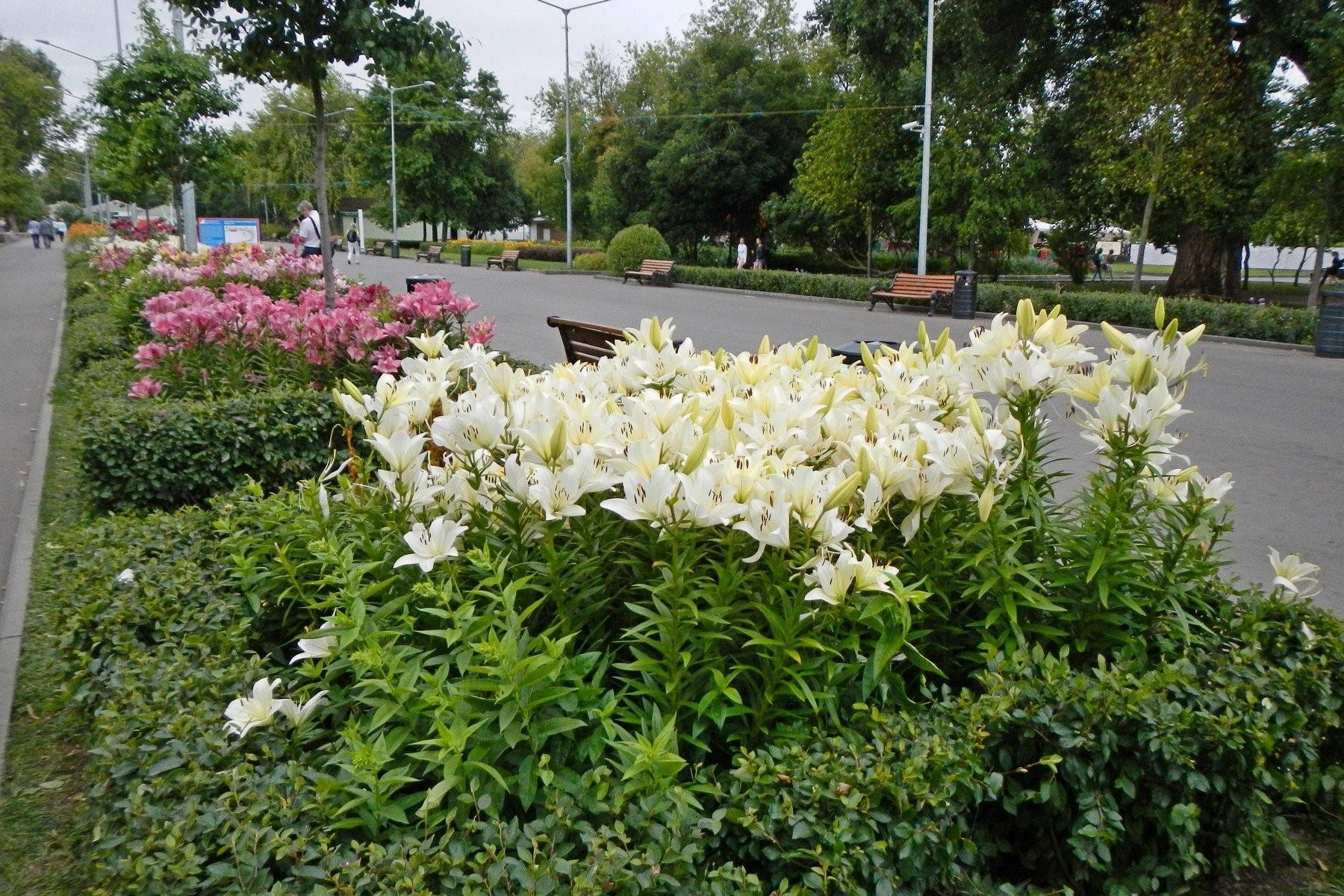Content
Asiatic lily is a lush flower that decorates gardens and parks. The plant is used in landscape design, as it is unpretentious, has different dimensions and colors (depending on the variety). You can grow an Asiatic lily almost anywhere if you provide it with proper care.
Origin story
For a long time, lilies grew in the wild, pollinating each other. This has led to an increase in species diversity. In the middle of the last century, plants began to be propagated artificially. Scientists Jan de Graaf and Peterson worked on Asian varieties.
Description and characteristics of Asiatic lilies
Modern representatives of the eastern group are hybrids. They are resistant to changing climatic conditions: changes in temperature and humidity, precipitation, and insufficient lighting. These qualities have made the Asiatic lily a welcome guest in many countries, including Russia.
The plant has a multi-colored color, in which white and orange tones usually predominate. The buds remain decorative throughout their life. They are collected in three-dimensional groups called inflorescences. One inflorescence can contain up to 28 flowers.

The culture is very winter-hardy, can withstand cold temperatures down to -40 degrees
Bushes may vary in height. There are dwarf varieties that grow up to 40-45 cm, and large lilies - more than 150 cm. The leaves are medium-sized and have a bright green color. The roots are represented by bulbs. Oriental hybrids also have surface roots that serve as additional supports for the stem.
How long does an Asiatic lily bloom?
Even if an Asiatic lily is planted in the spring, the owner will not be able to admire the flowering in the same year. It takes time for a young plant to form buds. The minimum period is 12 months. The process starts at the beginning of summer and lasts about a month.
The best varieties of Asiatic lilies
The category of best varieties included hybrid lilies. They have the qualities necessary for carefree cultivation - resistance to diseases and pests, frost resistance.
Brushmark
Brushmark is an Asiatic lily that has a unique coloring. Its petals are dotted with contrasting strokes.

Flowers can be beige, yellow, red and even brown
Annemarie dream
Annemaris dream (Annemaris dream) - a medium-sized perennial has received intense foliage, which makes it look like not an ornamental shrub. The bush is showered with lush flowers. The height of Annemarie Dream ranges from 40 to 230 cm.This variation is caused by different growing conditions.

Flower coloring: cream, blue, yellow or orange
Malvina
Malvina is a remarkable crop in that its buds have the habit of turning away from each other. As a result, the inflorescences became not just beautiful, but originally beautiful.

The Malvina variety is characterized by a half-open flower shape, as well as a weak aroma throughout its entire lifespan.
Lollipop
Another popular representative of the Asian group is Lollipop. This is a variety with a two-color color: the ends of the petals have a soft pink tint, while in the middle there is a white “cap”.

Asiatic lily Lollipop is easy to grow outdoors
Forever Susan
The Forever Susan culture has strong immunity, which made it immune to frost. The height of the bush barely exceeds 70 cm, so the Asiatic lily can be planted in a pot.

The coloring of Forever Susan buds is mixed: the middle is always dark and the tips are light
Brunello
Those planning to grow Asiatic lilies at home should not skip the Brunello variety. It has a compact size and exudes a pleasant tropical scent around itself.

Brunello is known not only among designers, but also among florists
How to plant an Asiatic lily
Experts do not recommend starting work in the middle of summer.

Asiatic lilies can be planted in spring and autumn - during periods when cold weather is not expected.
First of all, a site is selected for the plant that would correspond to the specific variety. Basically, lilies require a moist nutrient substrate with moderate lighting.
Only those bulbs that have passed a visual inspection are allowed for planting: they have no damage, stains, or signs of insect damage. After sampling, the raw materials are processed in Karbofos, following the instructions on the preparation.
While the Asiatic lily is being processed, there is time to prepare the area. A hole (40 cm) is dug in the area and a small amount of sand is poured. Then the hole is dug in again, and a small hill is formed at the top - the bulbs are placed on the side of it.
Sand is placed on top of the raw materials for planting and sprinkled with garden soil mixed with humus. The procedure is completed with abundant watering.
How to care for Asiatic lilies
Hybrids are distinguished by their unpretentiousness to external factors, so caring for Asiatic lilies is extremely simple. It involves feeding. The first is applied when the bush reaches 10 cm. An excellent fertilizer would be a solution of potassium nitrate, which is mixed with water for irrigation. Fertilizing is carried out twice a month, completely stopping at the time of flowering.
To prepare the Asiatic lily for winter, trim off any dry vegetation that has accumulated toward the end of the growing season.
Planting Asiatic lilies in the spring in the ground and in a pot is identical. But the care is somewhat different.You cannot grow a flower in one place, otherwise the buds will not open and there will be fewer of them. Therefore, every three years, Asiatic lilies are transplanted into new soil.
Another feature of oriental varieties is the absence of a shaping haircut. The owner does not need to fuss with pruning shears, choosing which shoots to cut and which not. But it is advisable to remove wilted leaves. If you do not plan to propagate Asiatic lilies in the near future, make sure that children do not appear on the bulbs. Otherwise, all the nutrients will reach them, and the mother plant will die.
Adult lilies produce daughter bulbs. They make the root system compressed, which is easy to notice at the top of the bush - the leaves become small, the number of flowers is reduced.

It is necessary to periodically replant the Asiatic lily to another place by digging a wider hole for it
Oriental varieties survive frosts without shelter - winter hardiness allows them. But in the season with little snow, the plant needs protection. The shelter can be a layer of spruce branches mixed with sawdust and peat. When the spring sun appears, the structure is removed so that the Asiatic lily forms shoots faster.
Reproduction
The crop is easier to propagate from bulbs. Work is carried out during transplantation. The daughter bulbs are separated from the parent plant and placed in fertilized soil. If there are several samples, a distance of 8 cm is maintained between each one.
Some Asiatic lilies can be grown from seedlings. Seed germination is on average 60-70%. At the same time, seedlings do not always inherit the characteristics of their parent. This type of propagation is practiced by scientists in order to develop new varieties.
Diseases and pests
Asiatic lilies have a strong immune system, which makes them extremely easy to grow. However, some varieties are resistant to fungal diseases, including:
- rust;
- fusarium;
- botrytis.
If symptoms are detected, use the fungicide "Fitosporin-M".
Insects pose no less of a threat to Asiatic lilies. Aphids and onion flies are frequent guests in garden plots. Pests are controlled with Aktara, which has a powerful effect but does not harm the plantings.
Application in landscape design

Several multi-colored varieties look good in one flower bed

Using lilies you can create a hedge

Planting along the fence

Lily is often used for landscaping park areas

The crop can be grown in a pot

Tall plants can be framed with small specimens
Conclusion
The Asiatic lily makes the garden beautiful, but does not burden the gardener with care. Even a person who knows nothing about this plant can handle planting. Those who want to achieve the maximum in cultivation should familiarize themselves with the characteristics of a particular variety: figure out how much water, light and fertilizing it needs.
Reviews of Asiatic lilies








